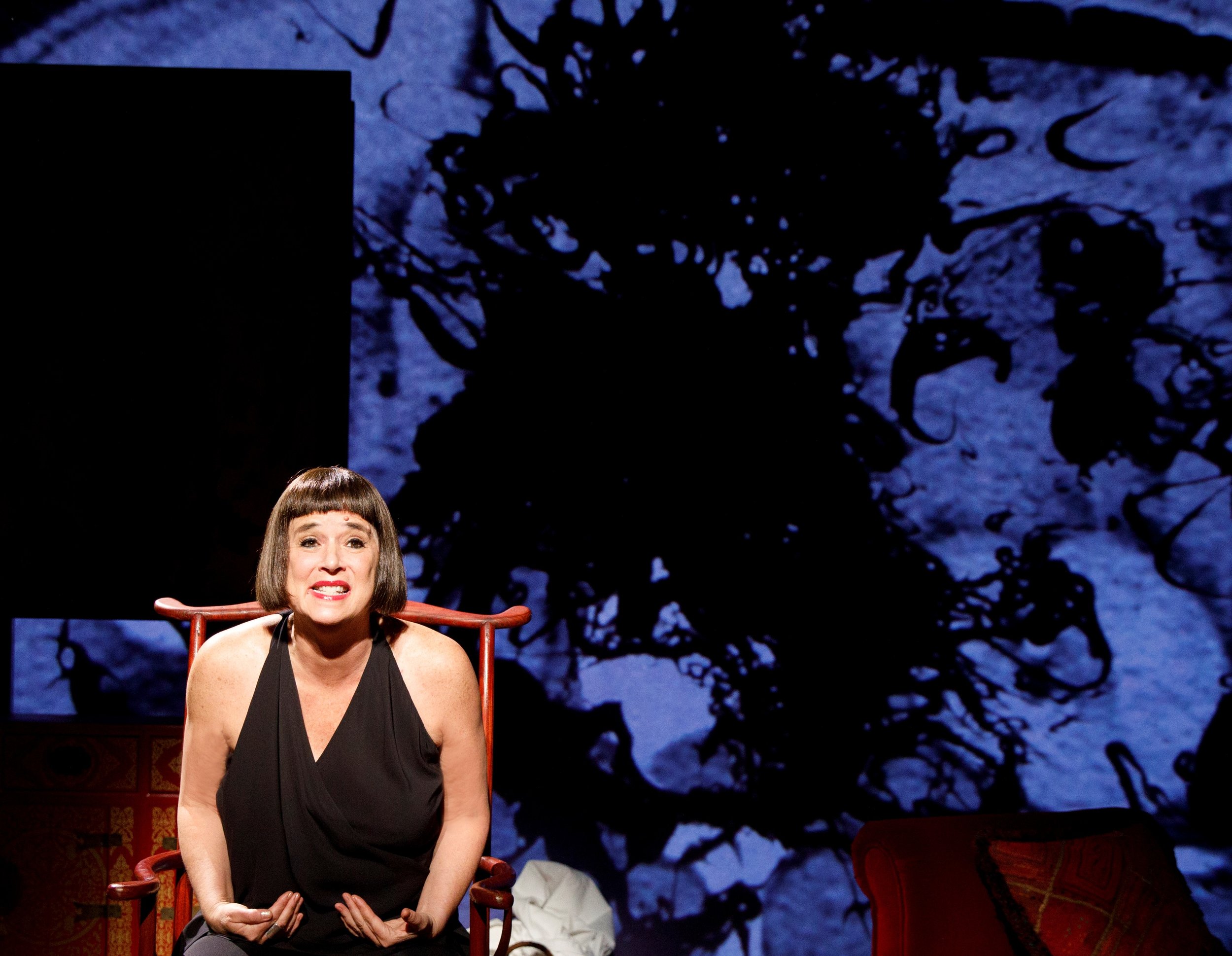The Manhattan Theatre Club stage at City Center is giving off major Disney World Jungle Cruise vibes these days. Birds call over the syncopated groove of Nigerian percussionist Solomon Ilori’s 1963 deep cut “Tolani (African Love Song)” as patrons enter the theater. There’s a Tara Buddha statue downstage right, some Persian rugs, a scarlet chaise lounge and some cushions on the floor, and the proto-Afrobeat music morphs into the Middle Eastern goblet drums and chirpy marimba that have been cornerstones of “world music” for decades. It’s almost disappointing when no chipper, punning Adventureland employee pulls up to take you downriver.
This geographical discombobulation is woven throughout In the Body of the World, written and performed by Eve Ensler. Based on her memoir, the play recounts Ensler’s struggle with the uterine cancer that disrupted her activist work with City of Joy, a “transformational leadership community for women survivors of violence” in the Democratic Republic of the Congo.
Eve Ensler enlists the audience in a “tree party” dance in her new solo show, In the Body of the World. Top: Ensler considers the ways cancer changed her inside and out.
Though Ensler posits any number of possible causes for her cancer (including, with her typical sharp wit, bad reviews, good reviews, and being reviewed), the point seems to be that in a world as troubled as this one, it’s only natural for biology to revolt. Ensler has predicated her influential corpus (The Vagina Monologues, The Good Body), often layered with her activist work, on reclaiming her body from sexual and societal violence, but as In the Body reveals, it took a skirmish with death to make it happen.
It’s only fitting, then, that these tensions should play out on stage. Always more confident as a writer than a performer, Ensler has nevertheless clearly made peace with her temple. She stumbles over line after line, but moves with a confident, hard-won ease born of the struggle she lays out detail by harrowing detail.
In the Body of the World is best when exploring those horrors with the frank humor that made The Vagina Monologues such a splash of cold water more than 20 years ago. A story about Cindy, a Beth Israel Hospital volunteer whose sole job is to get people to fart, highlights the absurdity underlying the trauma of disease.
Some lines land with a thunk—half-hearted applause greets the expectant pause following “Hysteria: a word designed to make women feel insane for knowing what we know!”—but a few are so gleefully self-aware they inspire shocked guffaws, such as “I never knew the difference between my anus and my rectum. Do you?” or Ensler’s response to a doctor wanting to attack the cancer with radiation. “Radiate my vagina? Do you have any idea who I am?!”
The play’s central metaphor is a powerful one in theory: the world is a body, and infection in one part will inevitably affect all others. But in practice the metaphor plays out in reverse: global traumas serve only as symbols of Ensler’s personal suffering. The World in My Body might have been a more appropriate title.
Doctors discovered pools of pus in her body the same day the Deepwater Horizon began gushing millions of gallons of oil into the Gulf of Mexico; climate change denial is like Ensler’s own refusal to believe anything was wrong with her body despite copious warning signs; anal fistulas resulting from rape are invoked as symbols more than once. The Congo is a savage land of rain, bad roads and no electricity. No metaphor there, but no nuance either. It’s cafeteria-style catnip for the Shithole Countries set, picking and choosing only those parts of the Global South that best serve Ensler’s narrative.
Ensler in contemplative mode. Photographs by Joan Marcus.
The mixed-metaphor apotheosis arrives at the play’s climax, with the story of Angelique, who, along with other women, is forced into a horrific act involving an infant. Ensler co-opts the tragedy to make sense of a prolonged bout of vomiting while under treatment.
Commandeering the Oppressed Other as an outlet and symbol for Western pain is as conventional as a three-act structure and hardly worth a mention. What really sets In the Body of the World apart, as filtered through director Diane Paulus’s (Waitress, Pippin) cosmopolitan sensibility, is the way it converts that pain into its own theme-park ride, crystallized when Myung Hee Cho's set opens to reveal a misty plastic “garden” (read: jungle) that Ensler invites the audience to explore at the conclusion. It’s Atrocityland, not Adventureland, that the audience has been cruising, with Eve Ensler as personal tour guide, ensuring the trip passes without so much as a single splash or ounce of discomfort.
Manhattan Theatre Club’s In the Body of the World runs through March 25 at City Center Stage I (131 W. 55th St., between Sixth and Seventh Avenues). Performance schedule varies week by week. For tickets and information, call CityTix at (212) 581-1212 or visit bodyoftheworldplay.com.





